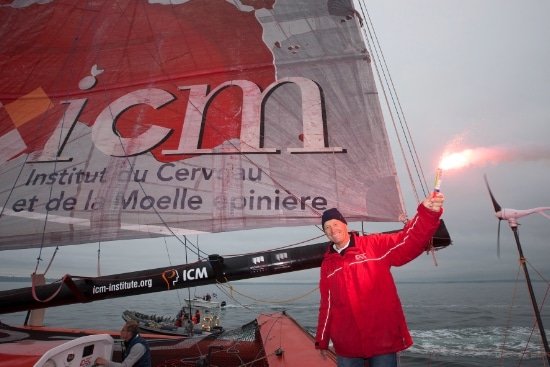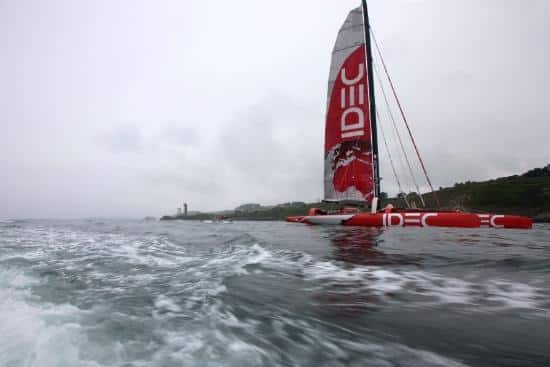
Francis Joyon IDEC
Francis Joyon had just broken the New York-Lizard transatlantic record a couple of days before I spoke to him last week, but you wouldn’t think that by speaking with him, given the matter-of-fact way he described his feat.
His publicists, though, were more vocal about his success, describing his record in terms of winning the “Grand Slam” of sailing. Indeed, after making the transatlantic solo crossing in five days and three hours, Joyon has also broken the 24-hour, east-to-west, and west-to-east transatlantics, and the Jules Verne around-the-world records. Call it what you will, but it could take decades before another sailor accomplishes a similar feat.
For the New York-Lizard transatlantic, Joyon said recent advances in weather-tracking technology helped him find the high-wind depression zones he needed so that his maxi-trimaran IDEC maintained 25 knot speeds on average. He also almost beat his 24-hour distance record of 666.2 miles during the last stretch of the route, thanks to 25-knot plus wind conditions he was able to find as he shaved more than 16 hours from Thomas Coville’s 2008 record.
Again, Joyon had a very technical and meat-and-potatoes way of describing his latest feat, but he did say one thing in particular kept him awake and focused while sleeping less than 10 hours in five days: the almost unthinkable of what could happen if he crashed his IDEC as the multihull glided up and over waves at 25 knots or more in the middle of the Atlantic.
How much did sailing in low-pressure zones in order to maintain an average speed of 25 knots account for your record transat time?
FJ: Remaining in low0pressure zones was certainly necessary and knowing when and how to find them certainly helped, but the forecasts of the two weather-tracking systems we used were different. One said that a low-pressure zone would remain in the English Channel, while the other one said it would veer toward the south. There is thus a lot left to chance when forecasts are different from each other. Even when different weather predictions are the same, their accuracy is not better than 80 percent. So in our case, we calculated that the forecast we relied on was not more than 50 percent accurate, so in many ways, we took a gamble. We decided that odds of 50/50 were not so bad after all when we made our decision.
The end result was making sure the boat was in the right place and time in the low pressure zones. The boat actually began to outrun the low pressure zone twice during the course. At one point, I had taken a more southerly route, so I tacked more toward the north to make sure I stayed where the wind was. That happened in the middle of the Atlantic, west of the Azores Islands.
How favorable were the wind directions?
FJ: The best wind angle for the boat is 130 degrees to the wind. I was actually able to maintain this angle to the wind during most of the trek with a southwest wind.
Were there any breakages?
FJ: Just one of the sail battens broke. My on-board PC was destroyed from a few waves that crashed on the cockpit and non-stop rain that made things even wetter. But I just used the emergency replacement PC I had onboard. As for the broken batten, it did not affect the mainsail too much.

©JMLIOT_DPPI_IDEC
So how were you able to maintain your concentration while only sleeping 10 hours in five days?
FJ: During much of the time, it did not require any effort to stay awake and to remain focused. When your boat is maintaining a 30-knot speed in 25 knots of wind and you know you only have five to six seconds to let down the sails [the French word is “choquer,” meaning to let down the sails in a way to slow down] if necessary, you don’t think much about sleeping.
Sometime, I slowed down the boat so I could rest, but only for a very short period of time. I would often go down below for a rest when the wind died down enough and the risk of capsizing was very low.
What was the biggest challenge that you faced?
FJ: The second day the wind speeds were unstable, with wind gusts of 40 knots. At one point, the boat speed was 35 knots. So it was difficult knowing when to add a reef or not and lose speed, or to maintain the sails and risk capsizing. During a couple of times then, the autopilot malfunctioned and I had to take the helm myself. There were a couple of times when I worried that I might lose control of the boat, but after I began helming the boat myself when the autopilot was not working properly, everything went well.
_Read more from Bruce Gain in his blog: _Postcard from Europe









